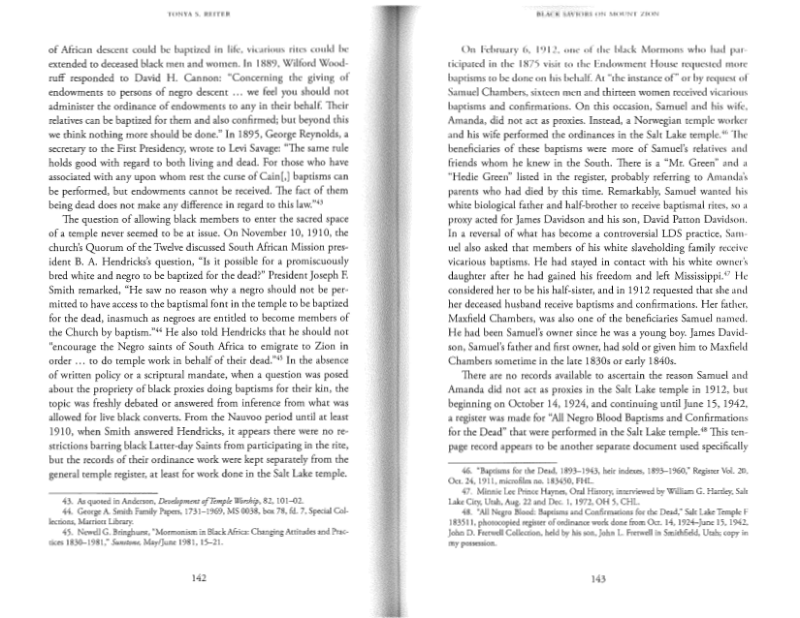Tonya S. Reiter describes register of white proxies and Black Saint requestors for baptisms for the dead.
- Type
- Book
- Source
- Tonya S. Reiter LDS
- Hearsay
- Journalism
- Reference
Tonya S. Reiter, "Black Saviors on Mount Zion: Proxy baptisms and Latter-day Saints of African descent," in The Ancient Order of Things: Essays on the Mormon Temple, ed. Christian Larsen (Salt Lake City, UT: Signature Books, 2019), 143–145
- Scribe/Publisher
- Signature Books
- People
- Tonya S. Reiter, bAner Leonard Howell, Paul Howell
- Audience
- Temples of The Church of Jesus Christ of Latter-day Saints
- Transcription
There are no records available to ascertain the reason Samuel and Amanda did not act as proxies in the Salt Lake temple in 1912, but beginning on October 14, 1924, and continuing until June 15, 1942, a register was made for ''All Negro Blood Baptisms and Confirmations for the Dead" that were performed in the Salt Lake temple. This ten-page record appears to be another separate document used specifically for listing vicarious work done for people of color, In it, the names of proxies, officiators, those for whom the baptisms were performed, and the person who requested the work to be done are all recorded. The register lists 163 baptismal recipients for the eighteen years it was kept. It is similar to the 1875 "Seed of Cain" record, except white proxies served for deceased black men and women, even when the person requesting the baptism was a black Latter-day Saint.
One of the baptisms recorded in this document is for a young boy, Paul Howell. His father, Abner Howell, was a prominent African American LDS convert who joined the church on February 26, 1921, just nine days after the death of his eight-year-old son, Paul. Paul's vicarious baptism was done in 1938 in the Salt Lake temple, but Abner did not serve as the proxy for his son, even though he was living in Salt Lake City at that time. He and his wife were sent to the South as unofficial LDS ambassadors in the 1950s, and he enjoyed presenting firesides as one of very few active LDS black men in Utah and later in California. He is known as a devout Mormon who would have done the work for his son if he had been allowed to do it. 50 There may have been reasons unrelated to race that prevented Abner from serving as proxy for his son, but he is not the only black member whose family was represented in the temple by white proxies.
In 1875, black Mormons had acted for their relatives and friends. Fifty years later, white members were evidently substituted for black members and the record of the ordinances was still segregated from the general register. The listing of Jane James's proxy baptism in the regular Logan temple register is the exception to the rule for Utah temple records.The apparent policy change to substitute white proxies for black relatives corresponds to the tenure of Apostle George F. Richards as Salt Lake temple president, but that could be coincidental. His view on the status of African Americans is in line with other early LDS leaders: "The Negro is an unfortunate man. He has been given a black skin. But that is as nothing compared with that greater handicap that he is not permitted to receive the Priesthood and the ordinances of the rernple, necessary to prepare men and women to enter into and enjoy a fullness of glory in the celestial kingdom." Richards is almost certainly referring to the LDS temple endowment, not baptisms, when he speaks of temple ordinances, but his message is clear: black members were not entitled to the same blessings as white Latter-day Saints.
- BHR Staff Commentary
The source for Reiter's information in her book is given as "All Negro Blood: Baptisms and Confirmations for the Dead," Salt Lake Temple, F 183511, October 14, 1924–June 15, 1942. BHR staff found a corresponding record listed in the FamilySearch catalog within "Baptisms for the dead, 1893–1943; heir indexes, 1893–1960," microfilms held in the Family History Library, United States & Canada 2nd Floor Film as Film 0,183, 511, Image Group Number (DGS) 5271076, Microfilm of manuscript. A search by FHL staff for the film on January 9, 2022 was unsuccessful. Tonya Reiter indicated that she held a copy of this record that she obtained from the "John D. Fretwell Collection, held by his son, John L. Fretwell in Smithfield, Utah" (see Reiter, p. 143n48).
The B. H. Roberts Foundation is not owned by, operated by, or affiliated with the Church of Jesus Christ of Latter-day Saints.

